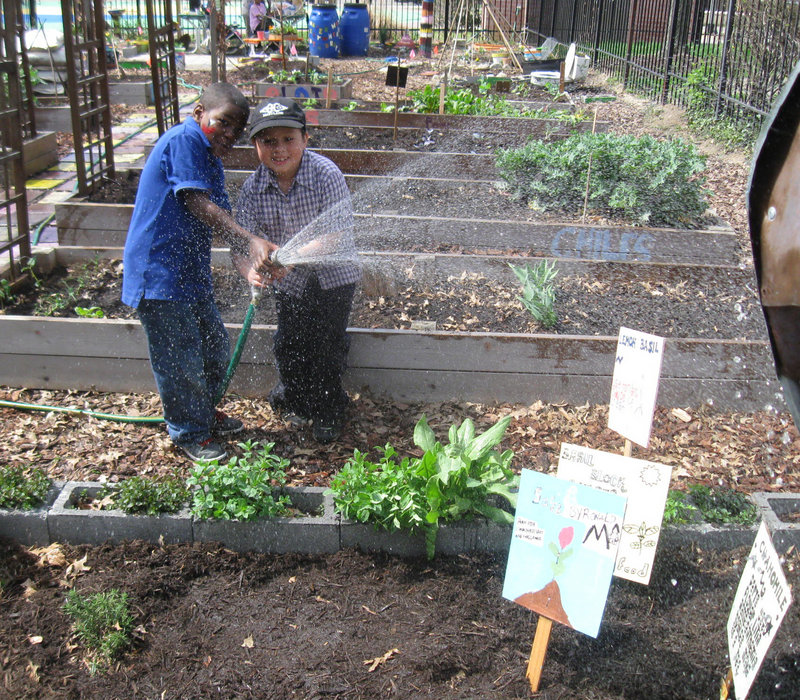WASHINGTON — There are marigolds and herbs, cosmos and phloxes, dianthuses and coreopsis and dozens of other plants in the garden maintained by City Blossoms, a nonprofit organization that teaches children in the D.C. and Baltimore areas how to grow plants.
“We use the garden to teach about expression, healthy living skills and community development,” says Rebecca Lemos, co-founder of City Blossoms.
For example, a recent workshop taught kids and their parents how to make bird feeders from soda bottles. Last month, they learned how to plant in containers.
Professional gardeners say the sooner children begin sprouting their green thumbs, the better.
Of course, gardening teaches them to grow their own food and make the Earth green. It also fosters independence and responsibility.
“It really does excite them when they have their own seeds and their own little gloves,” says Kaifa Anderson-Hall, program director of the Washington Youth Garden at the U.S. National Arboretum, which offers year-round gardening activities for families.
So how can parents get their kids to start planting?
The first step, Anderson-Hall says, is to take children to a nursery and allow them to choose a seed packet.
“Children love the colors of the seed packets,” she says. “Anything that’s bright or colorful, children will gravitate towards.”
Seed packets usually include instructions for caring for the plant, giving young gardeners an opportunity to practice their reading skills, too.
If children are interested in fruits and vegetables, Lola Bloom, co-founder of City Blossoms, suggests families visit their local farmers market to find out what grows well where they live.
Lemos encourages parents to research the gardening activities in their neighborhoods to get ideas on what to plant.
“Before you garden, go online and see what other community and school gardens are in the area. Visit botanical gardens. Walk around the community and see what you like,” Lemos said.
Next, it’s time to get dirty.
“I call it the ick factor. So many kids aren’t used to playing in the soil or touching soil,” says Lemos. “A lot of the kids we tend to work with grow up in the city. A lot of times they have very little exposure with the earth or the garden or even with nature.”
They also need to feel comfortable with insects commonly found in the ground, such as worms and ladybugs.
What to plant? Whether kids choose to start with flowers or vegetables, horticulturists say fast-growing plants will hold their interest.
Children get a kick out of seeing their plants blossom after a few weeks of sunlight and the right nutrients.
The City Blossom gardeners suggest radishes, sunflowers or cherry tomato plants for fast results. Lemos also suggests herbs like lavender and basil as starter plants. Children will enjoy smelling them and parents can use them for seasoning.
Randy Seagraves, curriculum coordinator at the National Junior Master Gardening program, says gardening can be a great way for children to expand their food choices.
“There are so many stories that we hear about kids not eating a carrot or radish,” he says, “but as soon as that kid grows that carrot or radish, he finds that he likes it.”
You could create theme gardens with foods kids like, says Norm Lownds, curator of the 4-H Children’s Garden at Michigan State University.
If they like pizza, for example, have them plant tomatoes, basil, oregano and peppers.
Harvesting root plants such as carrots or potatoes is also a favorite activity for children, Anderson-Hall says, because they can dig underground for the goods.
“It’s like magic, and you’re finding the treasure.”
Send questions/comments to the editors.



Success. Please wait for the page to reload. If the page does not reload within 5 seconds, please refresh the page.
Enter your email and password to access comments.
Hi, to comment on stories you must . This profile is in addition to your subscription and website login.
Already have a commenting profile? .
Invalid username/password.
Please check your email to confirm and complete your registration.
Only subscribers are eligible to post comments. Please subscribe or login first for digital access. Here’s why.
Use the form below to reset your password. When you've submitted your account email, we will send an email with a reset code.